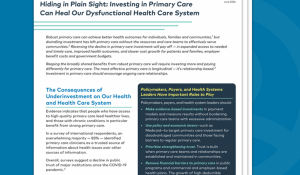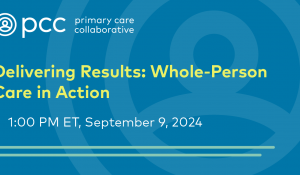You are looking at an archived version of our site. Please visit thepcc.org for a fresh, new experience!
You are here: Array » New Report Shows Prima ...
New Report Shows Primary Care Helped to Reduce Risk of Death, Infection from COVID-19
WASHINGTON, Oct. 18, 2021—A new report, Primary Care and COVID-19: It’s Complicated—Leveraging Primary Care, Public Health, and Social Assets, shows that primary care and other factors in the health system were effective in mitigating the negative effects of the COVID-19 pandemic. The report, released today, was produced by the PCC and the Robert Graham Center (RGC), a family medicine and primary care research organization.
The report found that in communities with the most robust primary care, the strongest public health infrastructure, and the fewest social vulnerabilities, residents were 42% less likely to die from COVID-19 and 12% less likely to get infected with the virus, as compared to communities on the other end of the spectrum. Data at the U.S. county level - from both before and after the COVID-19 vaccines were made widely available - were analyzed for the report.
Other main findings of Primary Care and COVID-19: It’s Complicated:
The report examined primary care access, strength of public health and degree of social vulnerability at the county level using a new construct - the Community Health Index (CHI) - developed by the RGC. The CHI was then compared to vaccination rates, incidence of COVID-19 infection before and after vaccines became available, and COVID-19 deaths before and after vaccines became available.
-
Counties scoring higher on the index were less affected by COVID-19: Counties with the highest scores for primary care access, strength of local public health, and social assets - those with the highest scores on the CHI - had better COVID-19-related outcomes (incident and death). These counties with the highest CHI (the top quintile) and the best COVID-19 outcomes represent 17% of the U.S. population. Counties that scored lowest on the CHI (lowest quintile) had worse COVID-19-related outcomes (incident and death), representing 20% of the U.S. population.
-
Higher scores meant higher vaccination rates: As CHI scores increased, vaccination rates did as well. Those people in the highest CHI quintile are 26% more likely to be vaccinated than those living in the lowest CHI quintile.
-
Higher scores brought COVID-19 rates down more quickly: After vaccines became available, COVID-19 incident and deaths fell across all U.S counties as expected, but the rates did not fall equally. Residents of counties with higher CHI scores were advantaged over their counterparts in counties with lower CHI scores, with rates of COVID-19 falling more quickly in the highest CHI quintile versus the lowest after vaccination commenced.
In addition to examining the empirical effects of primary care, public health and social vulnerabilities during the pandemic, the report’s aim is to raise questions for decision-makers about the adequacy of U.S. investment in critical health infrastructure and whether the country is adequately leveraging its existing infrastructure as the pandemic continues. These questions are critical to consider as the country puts strategies in place to emerge from the current pandemic and determines how to respond to future health emergencies.
“As we emerge from the current pandemic and re-imagine and rebuild primary care, we also need to look at other factors, such as investment in public health and community-based services,” said Ann Greiner, President and CEO of the PCC. “It is beyond time for us all to reach beyond our silos and join forces to address the widening health inequities that the pandemic laid bare and to better prepare for a future health emergency.”
“The title of this report - It’s Complicated - describes inter-related and mutually reinforcing factors critical in a high-risk situation like a pandemic,” said Yalda Jabbarpour, MD, RGC’s Medical Director. “Bringing all of these areas closer together will be challenging but essential in our continued efforts to combat COVID-19 and in preparation for future pandemics.”
Another implication the report identified is the importance of vaccination. After vaccinations commenced, all counties, regardless of their CHI, had a drop not only in COVID-19 cases, but also deaths. The report cites data that shows that states that depended on vaccination as opposed to natural immunity had lower death rates.
The report is the 10th annual evidence-based report by the PCC.
# # #
Learn more: Full report
These experts are available for interviews about the report:
- Ann Greiner, Primary Care Collaborative President and CEO
- Yalda Jabbarpour, MD, Medical Director, Robert Graham Center
- Glen Mays, PhD, MPH, Professor, Chair, Department of Health Systems, Management & Policy, Colorado School of Public Health
- Sinsi Hernández-Cancio, JD, Vice President for Health Justice, National Partnership for Women and Families
- Seiji Hayashi, MD, MPH, FAAFP, Chief Transformation Officer and Medical Director, Mary’s Center (Washington, D.C.)
- Mark Del Monte, JD, CEO/Executive Vice President, American Academy of Pediatrics
To arrange an interview, contact:
Stephen Padre
Communications Manager, Primary Care Collaborative
spadre@thepcc.org
202-417-3911

Are you a physician, nurse practitioner, or PA working in primary care?
Help PCC and the Larry A. Green Center track how your practice is responding to the COVID-19 outbreak by completing the Green Center's occasional survey.
The regular surveys are no longer being conducted.
COVID-19 Updates
May 9, 2022 | Primary Care Collaborative
April 19, 2022 | Primary Care Collaborative
April 19, 2022 | Primary Care Collaborative
March 7, 2022 | STAT
February 27, 2022
- 1 of 39
- next ›

Related Content:
Recent News
August 16, 2024
August 12, 2024
July 16, 2024
May webinar highlights: “The Commercial Market: Alternative Payment Models for Primary Care” Nate Murray explains w… https://t.co/KX9Wi2w6oY —
2 years 6 months ago
@CMSinnovates’ primary care strategy is rooted in a 2021 @theNASEM’s report which called #primarycare “foundational… https://t.co/glbPxvCysg —
2 years 6 months ago
@CMSinnovates has a new #primarycare strategy, envisioning “ACO-based primary care model tests that may focus on pr… https://t.co/aJGF1z411l —
2 years 6 months ago
- Page 1
- ››
Secondary menu
Copyright © 2024 Primary Care Collaborative




